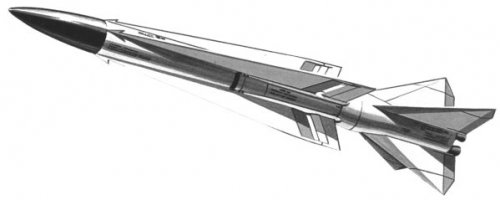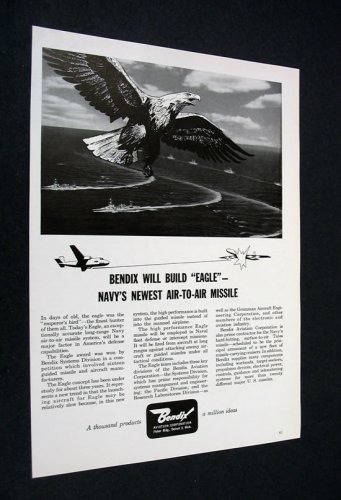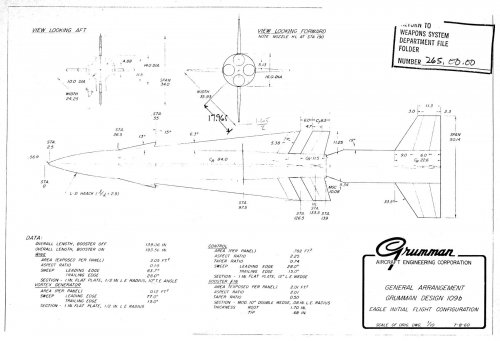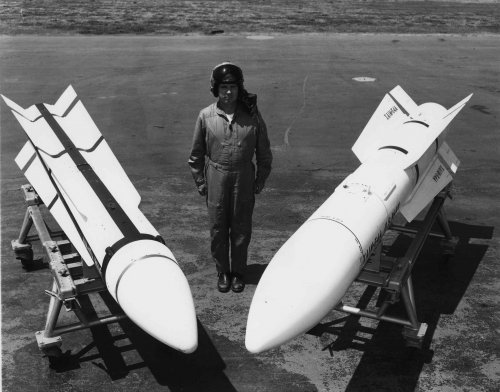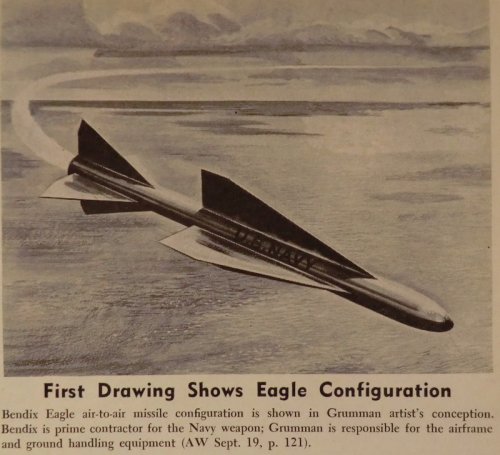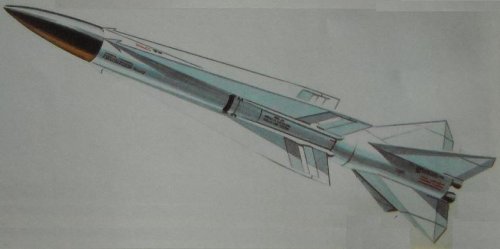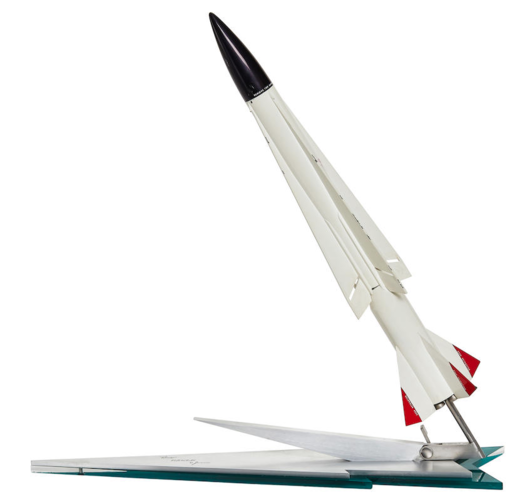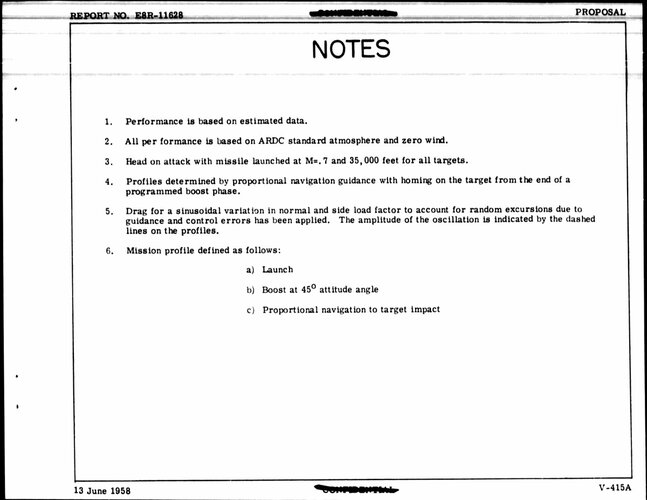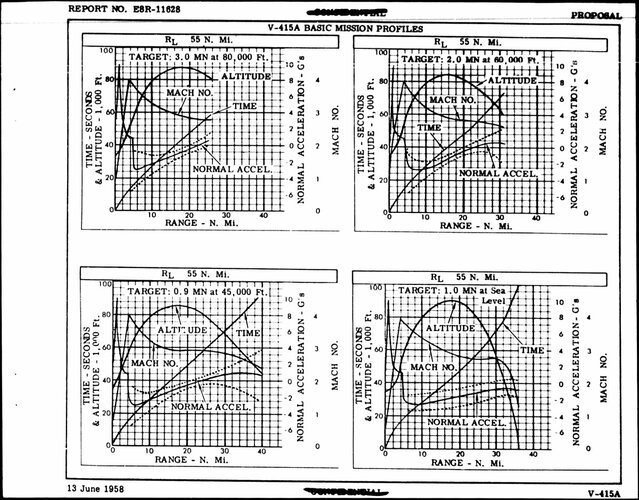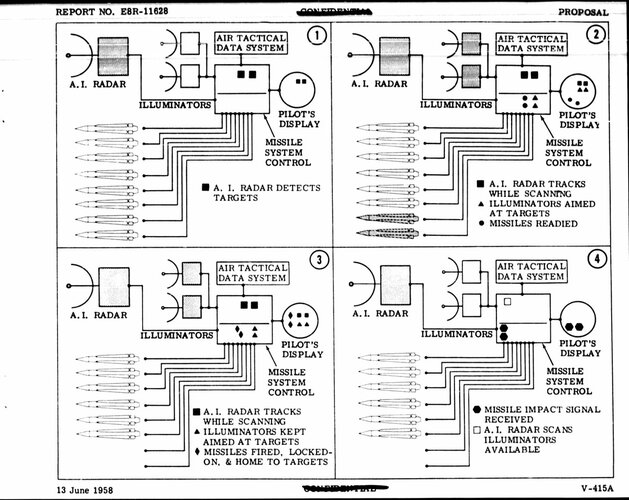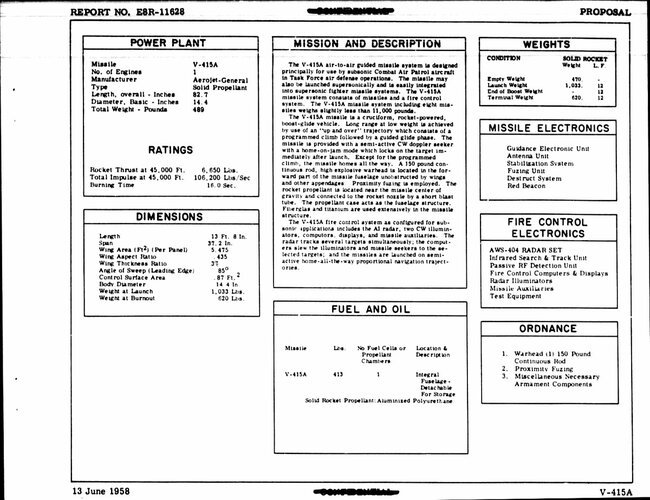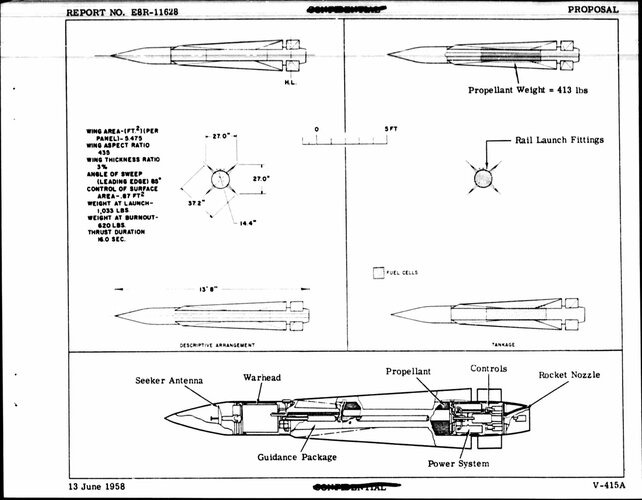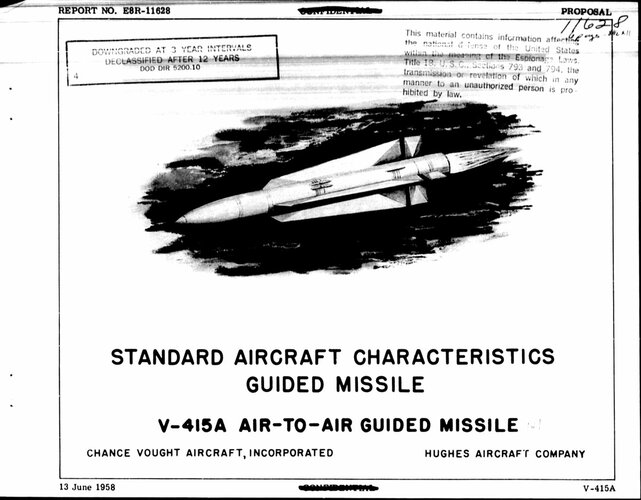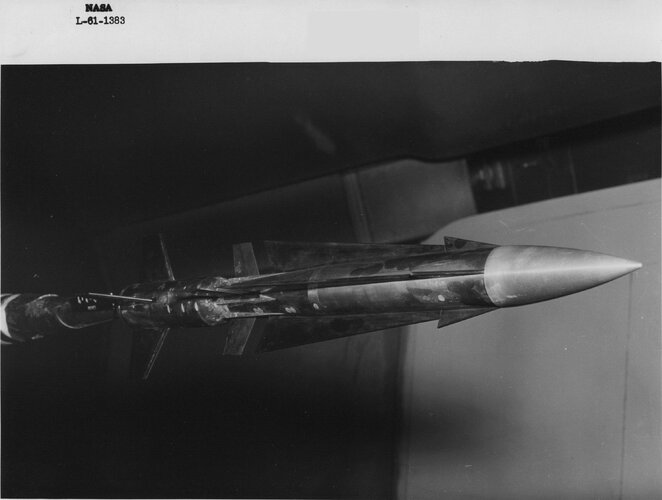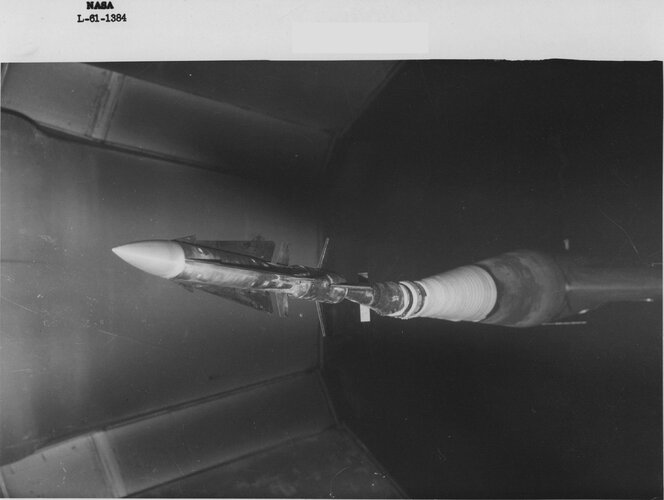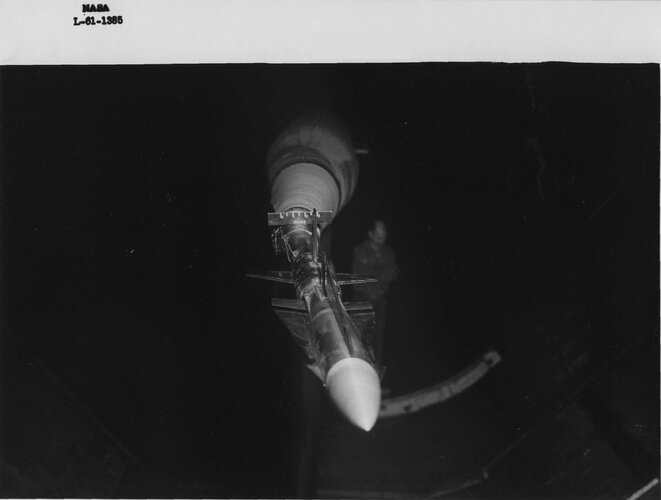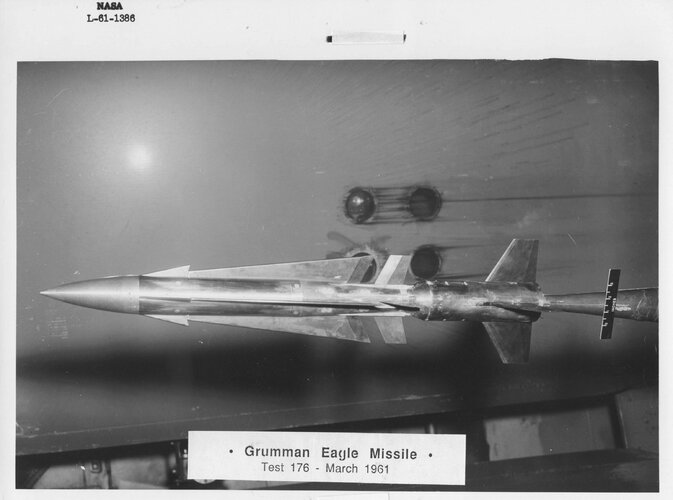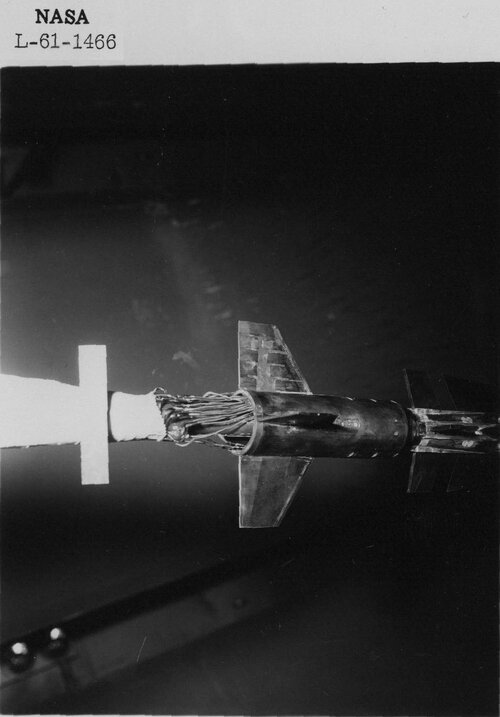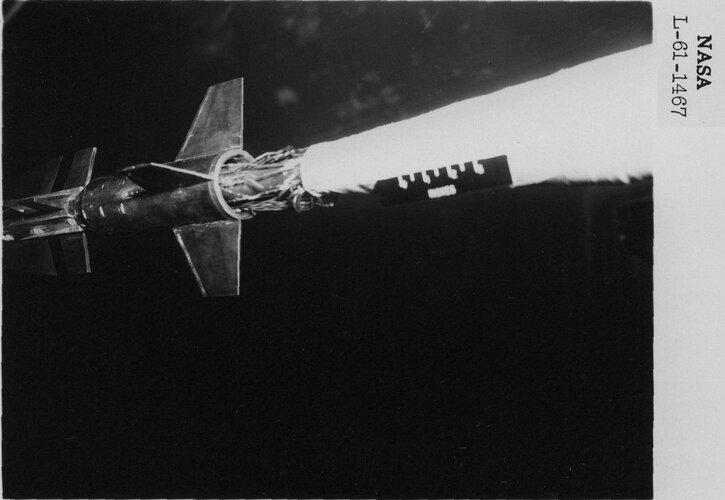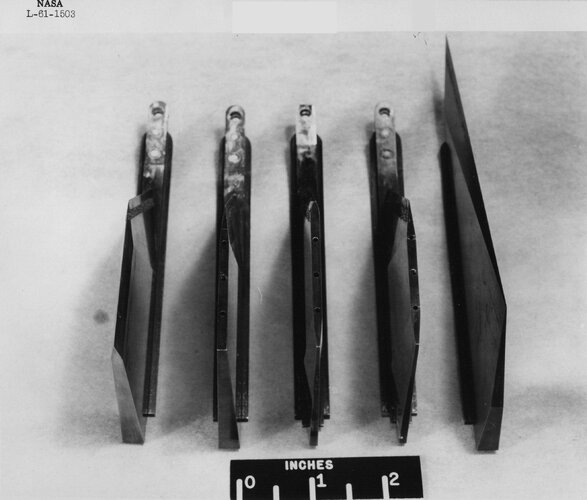A
You are using an out of date browser. It may not display this or other websites correctly.
You should upgrade or use an alternative browser.
You should upgrade or use an alternative browser.
Bendix AAM-N-10 Eagle AAM, rival proposals and developments
Pyrrhic victory
This is going to hurt
- Joined
- 31 January 2008
- Messages
- 73
- Reaction score
- 61
1959 Ad for the AAM-N-10 Eagle on Ebay
Attachments
Last edited by a moderator:
KJ_Lesnick
ACCESS: Top Secret
- Joined
- 13 February 2008
- Messages
- 1,042
- Reaction score
- 79
Anyone have any information on this missile, other than it was to be used by the F6D Missileer?
- Joined
- 27 December 2005
- Messages
- 16,452
- Reaction score
- 19,142
First, there's Andreas Partsch's site:
I have some more technical details on the seeker.
Sanders made the pulse doppler active radar seeker. 300w peak power, 100w average. PRF 150-300 kc/s. Dish diameter 12in. Beam width 15 deg. Frequency C band. Conical scan frequency (after acquisition) 200-300 c/s. Max closing speed Mach 8. Max doppler frequency of target 80 kc/s. Range accuracy +-1% of range or 1,000 yards. Guidance range 10nm. Weight of Sanders seeker 90lb + 35lb for Bendix supplied antenna and gimbal.
Aerial is plane polarised with 4 dipole feeds each followed by a ferrite modulator in order to produce an electronic conical scan in track mode. Gain quite low as affected by feeds used by Bendix in home-on-jam mode. Power generated by a Sperry reflex klystron (1w) fed via a ferrite isolator to Sperry 3 cavity klystron power amplifier with gain of 20-25dB.
The receiver used 9 banks of 11 filters.
Two home on jam systems were used. For all prfs there was a clear part of the doppler spectrum between 80 and 110 kc/s where no target or clutter signals should be seen. This could be used to distinguish jamming signals. Also a second receiver (by Bendix) produced midcourse guidance when the host aircraft's AI radar was jammed.
I have some more technical details on the seeker.
Sanders made the pulse doppler active radar seeker. 300w peak power, 100w average. PRF 150-300 kc/s. Dish diameter 12in. Beam width 15 deg. Frequency C band. Conical scan frequency (after acquisition) 200-300 c/s. Max closing speed Mach 8. Max doppler frequency of target 80 kc/s. Range accuracy +-1% of range or 1,000 yards. Guidance range 10nm. Weight of Sanders seeker 90lb + 35lb for Bendix supplied antenna and gimbal.
Aerial is plane polarised with 4 dipole feeds each followed by a ferrite modulator in order to produce an electronic conical scan in track mode. Gain quite low as affected by feeds used by Bendix in home-on-jam mode. Power generated by a Sperry reflex klystron (1w) fed via a ferrite isolator to Sperry 3 cavity klystron power amplifier with gain of 20-25dB.
The receiver used 9 banks of 11 filters.
Two home on jam systems were used. For all prfs there was a clear part of the doppler spectrum between 80 and 110 kc/s where no target or clutter signals should be seen. This could be used to distinguish jamming signals. Also a second receiver (by Bendix) produced midcourse guidance when the host aircraft's AI radar was jammed.
- Joined
- 27 December 2005
- Messages
- 16,452
- Reaction score
- 19,142
Last edited:
- Joined
- 27 December 2005
- Messages
- 16,452
- Reaction score
- 19,142
Whole bunch of wind tunnel photos of the Eagle here:
http://crgis.ndc.nasa.gov/historic/...w_Hypersonic_Tunnels_2#Grumman.2FEagle_Models
http://crgis.ndc.nasa.gov/historic/Test_176:_Bendix_(Grumman)_Eagle_Missile
http://crgis.ndc.nasa.gov/historic/...w_Hypersonic_Tunnels_2#Grumman.2FEagle_Models
http://crgis.ndc.nasa.gov/historic/Test_176:_Bendix_(Grumman)_Eagle_Missile
Last edited:
- Joined
- 13 June 2007
- Messages
- 2,029
- Reaction score
- 2,250
Steve Pace
Aviation History Writer
- Joined
- 6 January 2013
- Messages
- 2,266
- Reaction score
- 167
Theory: The Eagle missile was canceled and resurected as the Phoenix thus the name - it rose from the ashes of the Eagle. -SP
Steve Pace said:Theory: The Eagle missile was canceled and resurrected as the Phoenix thus the name - it rose from the ashes of the Eagle. -SP
I've recently done some more digging on the F-111B for an article. Part of the result was sorting out the Eagle vs. Phoenix missile. The Eagle was a two-stage air-to-air missile being designed by Bendix with Grumman as a subcontractor for the airframe. It was canceled along with the F6D. The Navy subsequently selected Hughes to develop both the Airborne Missile Control System (AMCS) and Long Range Air-to-Air Missile (LRAAM) that were based on its work on the Air Force YF-12 interceptor program . The Navy missile was designated AIM-54. As you wrote, it was named Phoenix probably because it had risen from the ashes of the Missileer program, although it might possibly have referred to its resurrection from the ashes of the Air Force program. It was single-stage, with somewhat less range compared to the Eagle, offset by the supersonic dash capability of the F-111B now that the radar antenna was only three feet in diameter.
The picture was furnished by Anthony Thornborough. The Air Force AIM-47 is on the left and the Navy AIM-54 on the right.
Attachments
Steve Pace
Aviation History Writer
- Joined
- 6 January 2013
- Messages
- 2,266
- Reaction score
- 167
Well said! -SP
- Joined
- 3 June 2011
- Messages
- 17,332
- Reaction score
- 9,060
Steve Pace said:Theory: The Eagle missile was canceled and resurected as the Phoenix thus the name - it rose from the ashes of the Eagle. -SP
Pretty sure it was the AIM-47 Falcon's ashes the Phoenix rose from. Eagle was from a different company.
edit: Looks like SP beat me to it.
- Joined
- 24 January 2006
- Messages
- 1,304
- Reaction score
- 310
sferrin said:Steve Pace said:Theory: The Eagle missile was canceled and resurected as the Phoenix thus the name - it rose from the ashes of the Eagle. -SP
Pretty sure it was the AIM-47 Falcon's ashes the Phoenix rose from. Eagle was from a different company.
edit: Looks like SP beat me to it.
Error. AIM-54 development began as the AAM-N-11 in late 1960. Hughes built off of the AIM-47 and AN/ASG-18 to develop the AIM-54 and AWG-9, but there was a time during the Phoenix's development when both missiles/radars were going to enter service. Phoenix being resurrected from the Eagle does make sense from a program standpoint, as the F-14 replaced the F-111B which replaced the Missileer, in terms of being the fleet air defense LRAAM shooter.
Now, the F-108/AIM-47 combo was cancelled in late 1959, so that might be where the Phoenix "rose" from as well, although the AIM-47 and AN/ASG-18 did still continue development.
- Joined
- 25 June 2009
- Messages
- 13,773
- Reaction score
- 3,043
sferrin said:Pretty sure it was the AIM-47 Falcon's ashes the Phoenix rose from. Eagle was from a different company.
Yes, but when it comes to missiles, the company is not necessarily a given. There have been numerous examples of missiles or rockets started by a certain company and later produced by another.
Artist's impression of Bendix XAAM-N-10 Eagle missile.
Source:
Source:
Attachments
- Joined
- 22 April 2012
- Messages
- 2,318
- Reaction score
- 1,839
A Bendix Eagle model came up for sale at Bonhams in 2019:
BENDIX GRUMMAN EAGLE MISSILE MODEL.
Contractor's model in wood and metal, on aluminum base, engraved on the base with Bendix and Grumman logos, and "Eagle," 20 x 3-1/2 inches diameter, excluding stand, in custom wood box. Traces of felt residue from box adhering to fuselage.
Provenance: Manufactured by a major aerospace model shop.
The AAM-N-10 Eagle missile was developed by Bendix for the U.S. Navy, and manufactured by Grumman for testing in 1961. It was intended to be launched from a carrier-based Douglas F6D "Missileer" aircraft, and would have a range of 160 nautical miles. The Navy cancelled the Missileer project before the missile was even tested, and without the aircraft that it was intended for, it was never put into production.
Attachments
Last edited:
What are these other connections?These two were loosely related at many levels...
Now to clarify my previous post the BOMARC instead of having conventional ailerons had all-moving wing-tips.
One final thing does anyone know if any prototype missile hardware was built and tested before the Eagle was cancelled?
I stumbled across this interesting article by someone who was involved in the programme:
Navy Electronic Warfare
He also filed a patent to do with the Eagle - Method of Determining the Launch Time of Air-to-Air Missiles
Navy Electronic Warfare
He also filed a patent to do with the Eagle - Method of Determining the Launch Time of Air-to-Air Missiles
- Joined
- 3 June 2011
- Messages
- 17,332
- Reaction score
- 9,060
Any info out there about the "V-415A" missiles? I've wondered about them since I saw them in your book.
- Joined
- 17 May 2008
- Messages
- 675
- Reaction score
- 1,321
I am sure that I posted these previously to this site, however it must have been a dream. All apologies if this is a repeat. Here is the SAC for the V-415AAny info out there about the "V-415A" missiles? I've wondered about them since I saw them in your book.
Attachments
Scott Kenny
ACCESS: Above Top Secret
- Joined
- 15 May 2023
- Messages
- 5,947
- Reaction score
- 4,789
Woof, that is a big beast of a missile. 415lbs of propellant. 1000lbs all in.I am sure that I posted these previously to this site, however it must have been a dream. All apologies if this is a repeat. Here is the SAC for the V-415A
Surprised that Vought couldn't figure out how to fit 4x Sparrows on the Crusader 3, though. 2x on the fuselage corners and 2x staggered off the centerline instead of 1x on the centerline.
- Joined
- 27 December 2005
- Messages
- 16,452
- Reaction score
- 19,142
I missed this - a great article!Enjoy!
Article on the AAM-N-10 Eagle.
- Joined
- 27 December 2005
- Messages
- 16,452
- Reaction score
- 19,142
Grumman 327 for Naval TFX fits into the AAM-N-10 / AIM-54 picture somewhere. Grumman were responsible for the Bendix AAM-N-10 airframe and production.
- Joined
- 27 December 2005
- Messages
- 16,452
- Reaction score
- 19,142
Interesting missile. Semi-active radar homing using CW. The associated radar has 2 x CW illuminators that seem to be separated from the main antenna to allow continuous illumination of two targets while the main radar does track-while-scan.I am sure that I posted these previously to this site, however it must have been a dream. All apologies if this is a repeat. Here is the SAC for the V-415A
- Joined
- 27 December 2005
- Messages
- 16,452
- Reaction score
- 19,142
Thanks to Wikimedia, I have recovered some of these pictures.Whole bunch of wind tunnel photos of the Eagle here:
http://crgis.ndc.nasa.gov/historic/...w_Hypersonic_Tunnels_2#Grumman.2FEagle_Models
http://crgis.ndc.nasa.gov/historic/Test_176:_Bendix_(Grumman)_Eagle_Missile
Attachments
- Joined
- 16 April 2008
- Messages
- 8,391
- Reaction score
- 10,316
P
Roughly Phoenix sized. Eagle was even bigger, thanks to the booster.
Woof, that is a big beast of a missile. 415lbs of propellant. 1000lbs all in.
Roughly Phoenix sized. Eagle was even bigger, thanks to the booster.
- Joined
- 27 December 2005
- Messages
- 16,452
- Reaction score
- 19,142
AWST 15 Sep 1958Tight Defense Department fiscal policy may force Navy to abandon its Eagle long—range air-to-air missile now in the early phases of development in favor the Hughes GAR-9 being developed for the Air Force for use on the North American F-108 Mach 3 fighter. Both missiles have similar capabilities and both would be equipped with nuclear warheads, but GAR—9 is further along the development path.
Eagle AAM was in development significantly before the FAD / Douglas Missileer.
AWST 29 Sep 1958Navy has won its battle with Defense Department fiscal planners over the fate of the Eagle long-range air—to—air missile. Fiscal officials, faced with a tight budget, had asked Navy to adopt Air Force’s GAR-9 designed for the F-108 and abandon the Eagle for economy reasons (AW Sept. 15, p. 23). Navy, however, contended that the Hughes missile would not fit the Eagle’s intended mission. Eagle is scheduled to be carried by the Grumman A2F attack plane now under development.
Eagle is scheduled to be carried by the Grumman A2F
attack plane now under development.
Seriously? An attack aircraft (The A-6) carrying a sophisticated long-range AAM without the appropriate fire-control system.
- Joined
- 29 September 2006
- Messages
- 1,628
- Reaction score
- 1,028
Has to be crossed-wires - an A-6 derived missileer, surely?Seriously? An attack aircraft (The A-6) carrying a sophisticated long-range AAM without the appropriate fire-control system.
Fact is that one of Grumman missileer designs looked like an A-6 Intruder (or I think there was a Missileer Intruder hybrid proposal). Always thought they should have turned the Skywarrior into a makeshift Missileer. N.A suggested to do that, with the D-766 and D-790 projects. The APQ-81 / Eagle testbed was to be a Skywarrior, already modified with a huge nose. Maybe the Skywarrior would have carried the day in the end.
Last edited:
- Joined
- 27 December 2005
- Messages
- 16,452
- Reaction score
- 19,142
Subsonic Missile-Platform Aircraft May Play Important Navy Role
Washington—Grumman A2F-1 attack plane now under development may be the forerunner of a series of subsonic navy “Missileer” missile platform aircraft for use in both interceptor and attack roles.
“Missilcer,” new name for the earlier, and much-debated, “slow plane” concept, envisions use of a subsonic aircraft carrying highspeed, long—range
air-to-surfacc missiles as an attack plane, long-range air—to—air missiles as an interceptor.
The Soviet Union apparently already has partially turned to the “slow plane" concept in the development of interceptor aircraft, a role which appears to hold more promise for such a plane than the attack mission.
All-weather models of the Yak Flashlight interceptor carry radar large enough to fire missiles on long—range intercept missions at distances of up to approximately 50 mi. The Soviets also are developing a 75—mi.—range air-to-air interceptor missile (A\V Sept. 8, p. 23) that operates as a beam rider
until it reaches the vicinity of its target. An internal homing device apparently takes over to guide the missile on its fiinal run to the target.
The AZF—l, for which Grumman received a development contract in January (AW Jan. 6, p. 34), will be designed to hold a speed of approximately Mach 0.9 at sea level. As an attack plane, it will fire its air—to-surface missiles, probably the Temco Corvus, about 75 mi. from the target. Powcrplants are two 7,500 lb. thrust Pratt & Whitney J52 engines.
Navy hopes that the A2F, by flying as close to ground level as possible, can escape radar detection until it has had a chance to fire its missiles and that its Mach .9 sea level speed will provide adequate protection against a high speed interceptor whose performance is relatively poor at low altitudes.
The two—place A2F. carrying a pilot and radar operator, also may be used as a carrier—based interceptor when equipped with Eagle air-to-air missiles
(AW Sept. 29, p. 15). Eagle will have a range of 30 mi plus.
Bidders in the Eagle competition have included Chance Vought, General Electric, United Aircraft, North American Aviation and Douglas Aircraft plus two tcam proposals—Convair, Sperry Rand and Radio Corp. of America on the one hand, Bendix and Grurnman on the other.
As an interceptor, the A2F would operate at substantially higher altitudes, probably gaining some increase in speed.
The aircraft will be equipped with an inertial guidance system under development by Litton Industries. The system employs an extremely small, lightweight, stabilizcd platform using two degree of freedom floater gyros.
Inertial guidance systems. which will be employed in most of Navy's firstline combat aircraft in the future, have the advantage of being self-contained and require no electromagnetic radiation from ship, shore or other aircraft that could reveal the presence of the aircraft or could be jammed by enemy countermeasures.
Intended primarily for carrier operations. the AZF also is being designed to incorporate a short—field capability for use from land bases when necessary. In formally announcing the decision to let a contract for the A2F, Vice Adm. R. B. Piric, deputy chief of naval operations for air, last week explained much of Navy’s philosophy behind the “Missileer” interceptor concept. Speaking at an Aviation Writers Assn. meeting here, Adm. Pirie said:
“The present combination of fast fighters carrying short—range missiles comprises the airborne portion of our task force defense against air attack. Intercepts must be made at relatively short range with little time available. With missile and radar development what it is, why must we bore supersonic holes in the air for air defense? A follow-on fighter concept is the answer. This concept exploits sophisticated long—range detection devices. It depends more and more on the high Mach speed ability of missiles to make the kill of attacking bombers."
Adm. Pirie said other military serrices also arc studying the concept. A true “Missileer” aircraft, Pirie said, “would be a virtual heavy cruiser of the air. It could track more than one target and control more than one missile at a time. It could stand off the enemy from many directions withits missiles.
Eagle in Doubt
Washington — Defense Department fiscal planners are again pressuring Navy to abandon its competition for development of the Eagle long-range air-to-air missile in favor of the Air Force-Hughes GAR-9 scheduled for use on the North American F-108 interceptor.
Late last summer, Defense had urged Navy to abandon the Eagle for economy reasons and adopt the GAR—9, which is futher along the development cycle (AW Sept. 15, p. 23). Later, it bowed to Navy arguments that the Hughes’ missile would not fit into the Eagle’s intended mission (AW Sept. 29, p. 15).
Now however, Defense planners, faced with a tight Fiscal 1960 budget, are once again pushing Navy to accept the GAR-9. DeSpite the pressure, Navy still hopes to retain the Eagle. Final decision on the contract had been scheduled for Nov. 15, with the team proposals of Grumman- Bendix and Convair-Sperry Rand-Radio Corp. of America apparently in the lead for the award.
AWST 10 Nov 1958
Last edited:
- Joined
- 27 December 2005
- Messages
- 16,452
- Reaction score
- 19,142
My guess would be that the Convair proposal was based on the RIM-2E Terrier/Tartar missile family in configuration.
My guess would be that the Convair proposal was based on the RIM-2E Terrier/Tartar missile family in configuration.
Is there a photograph/drawing of it?
- Joined
- 27 December 2005
- Messages
- 16,452
- Reaction score
- 19,142
Not so far, no.
Similar threads
-
-
-
XAAM-N-11 for TFX Phoenix Design Proposal Competition
- Started by Pioneer
- Replies: 13
-
Fairey Semi-Active Guided Weapon
- Started by overscan (PaulMM)
- Replies: 16
-

